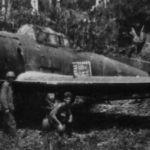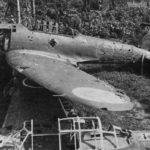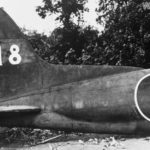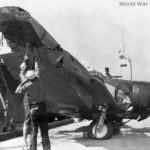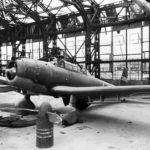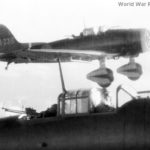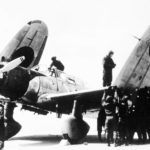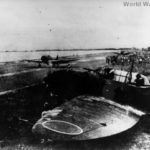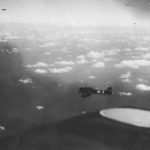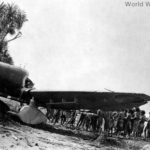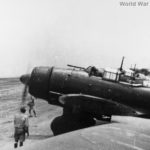D3A1 EII-206 takes off from carrier Zuikaku 20 January 1942
Dive bomber Aichi D3A2
This Val, which was a part of the 33rd Kokutai, had its rear canopy removed to provide the rear-seater with a wider field of fire. This configuration was commonly used during service.
Aichi D3A T3-261 of 582nd Kokutai Munda Airfield 1943
D3A2 Q218 of the 2nd Kokutai Deba Beach, New Guinea 3 September 1942
D3A Lakunai 2 November 1943
Wreckage of Japanese D3A1 Val from Carrier Kaga at Pearl Harbor
Wreckage of Japanese Type 99 Aichi D3A Val on Beach of Guam
Yokosuka D3Y1-K “Venus” at Atsugi Japan 1945
Aichi D3A Type 99 code EI-235 from Shokaku, 1942
1st Marine Division encounters wrecked Japanese D3A2 1944
D3A2 AI-207 takes off from carrier Akagi, April 1942
Aichi D3A1 kanbaku
“Val” 81-241 of 1081 Kokutai,
D3A1 and G3M, 11 October 1940
Vals kamikaze preparing for takeoff 1944
D3A1 EI-208 from Shokaku 8 May 1942
Wreckage of Aichi D3A1 Model 11 T3-261 of 582nd Kokutai Munda 1943
Wreckage of Aichi D3A1 New Guinea 3 September 1943
D3A2 kanbaku
Dive bomber Aichi D3A2 Val in flight
The Kanjo Bakugeki was a Japanese naval dive bomber that was first developed in 1936 as the “11-Shi Carrier Bomber”, and was ordered and produced by Aichi Aircraft (which became independent from Aichi Watch Electric in 1943) during the early stages of the Pacific War. Its abbreviated name was the Type 99 or the Type 99 Kanbaku. Its symbol was D3A, and its American codename was Val.
Initially, the Navy ordered Nakajima, Mitsubishi, and Aichi to develop prototypes, but Mitsubishi abandoned the project early on, and Nakajima and Aichi competed to develop the aircraft. It was decided to use an improved version of the existing Nakajima “Hikari” 1 engine for the Type 96 bomber. The Aichi was based on the German Heinkel He 70 (the Navy imported a civilian version), with all-metal monoplane construction, fixed gear, dive brakes on the underside of both wings,, and elliptical ends on the wings and tail. Val made its first successful flight in 1938. At the beginning of its development, the aircraft’s behaviour was unstable and it had to be modified many times. A particular problem was the unintentional rotation of the aircraft due to wing tip stall. This was solved by increasing the torsional lowering of the wings and adding a fin in front of the vertical tail fin. This aircraft was made as a competitive prototype with Nakajima’s, but Nakajima’s D3N1 was disqualified due to the delay in delivery because the design could not be completed in time to meet the Navy’s changing requirements. As a result, on December 16, 1939, this aircraft was officially adopted by the Navy as the ” Navy Type 99 Carrier Bomber Model 11 “. Mass-produced aircraft was powered by Mitsubishi’s Kinsei 44 or 43.
By the beginning of the Pacific War, the Model 11 had become insufficient in terms of performance, so in August 1942, an improved prototype was built, tentatively called the Model 22. Then, in January 1943, it was officially adopted as the D3A2. Engine was replaced by the Kinsei Type 54 (1300hp), and the propeller spinner was added, the windshield was extended at the rear, and the engine cowling and the leading edge of the tail plane were changed. These modifications improved the speed and climbing power, but reduced the cruising performance. The Model 22 began to be deployed in early 1943.
Production began in 1939, with Aichi producing 476 D3A1 (including an increased number of prototypes) and 816 Type D3A2s. In addition, 220 late production D3A2 were produced at Showa Aircraft Co. Of these, 135 were still in production at the end of the war. Some of the D3A2 were converted into training planes with a control unit in the rear seat. These aircraft were provisionally called the Type 99 Bomber Trainer Model 12 (D3A2-K). Yokosuka D3Ywith an all-wood fuselage, was undergoing testing at the end of the war. Together with the Type Zero fighter and the B5N the Kunbaku supported the successful advance of the Imperial Japanese Navy in the early stages of the Pacific War, and showed a high dive bombing hit rate in the Pearl Harbor attack and the Easter Sunday Raid. 78 D3A took part in the attack on the ships, and 78 bombs were dropped, of which it was estimated that 47.7% were sure to hit. According to the American judgment, the 250kg bombs hit the battleship USS Nevada more than six times, the battleship USS Maryland and Pennsylvania one each, the light cruiser USS Helena and Raleigh one each, the destroyer USS Cassin, Downs and Shaw one each.
Following this, dive-bombers were deployed in the southern campaign. In late January 1942, the carrier task force attacked Rabaul, Kavieng, Lae, Salamore, Madang, and Ambon, and on 19 February, it bombed Port Darwin, inflicting heavy damage on airfield facilities and ships in port. On 19 February, she bombed Port Darwin, severely damaging airfield facilities and ships on station, sinking 21 of 46 ships in Port Darwin, two outside the bay, seaplane tender USS William B. Preston, nine large cargo ships, and a total of 43,429 tons at sea. On the 27th of the same month she attacked Chiracap, and on the 1st of March she sank the oiler Pecos off Christmas Island, as well as the destroyer USS Edsall. The nine Kaga bombers that attacked Pecos were hit by only one shell. At sea, the merchant ships”Boulau Brass and Woolgar were sunk by the Type 99 bombs.
In the Battle of Ceylon, she also showed a high bombing hit rate, and on April 5, she sank the Royal Navy heavy cruisers HMS Cornwall and Dorsetshire in less than 20 minutes from the start of the attack. 53 D3A participated in the attack of which were launched from Akagi, Soryu and Hiryu. On the 9th of the same month, off the coast of Batticaloa, the aircraft carrier HMS Hermes and the destroyers Vampire, corvette HMS Hollyhock, the tanker Acelstein, and British Sergeant were sunk in an attack by 85 aircraft launched from Akagi, Soryu, Hiryu, Shokaku and Zuikaku. HMS Hermes were bombed by 45 aircraft and hit by 37 bombs, with an average hit rate of 82%.
After this, the 99 Kanbaku continued to be used in the battlefield, and its war history includes the Battle of the Coral Sea, the Battle of Midway, the Battle of the Solomon, the Battle of the South Pacific, Operation “I”, Operation “Ro”, the Battle of the Mariana, the Battle of the Philippine Islands, and the Battle of Okinawa. In the Battle of the Coral Sea, the Shokaku and Zuikaku bombers were deployed. On 7 May 1942, she sank the destroyer USS Sims and also destroyed a oil tanker. The following day, on the 8th, a decisive battle was fought, and 33 D3A participated in the attack, hiting aircraft carrier USS Lexington with two 250kg bombs and another hit on USS Yorktown. The Lexington was heavily damaged in the attack and was sunk by American destroyers. The losses of the bombers were nine. At the Battle of Midway, while Akagi, Kaga and Soryu were sunk, Hiryu made two counterattacks and damaged Yorktown. Eighteen Vals took part in the first attack. Although three 250kg bombs were hit by the D3A, 13 of the 18 aircraft were lost. Yorktown was badly damaged, and the next day she was struck by the Japanese submarine I-168 and sank.
During the Second Battle of the Solomons on 24 August 1942, the Shōkaku and Zuikaku bombers attacked the aircraft carrier USS Enterprise, with 27 Kanbaku sorties and dive bombing. USS Enterprise was hit by three bombs. The Enterprise was damaged and retreated, but the bombers lost 23 planes. In the Battle of the South Pacific, on October 26, 1942, 21 planes of Zuikaku’s bomb squadron sortied and hit the carrier USS Hornet with five bombs. Nineteen aircraft of the Shōhaku bomb squadron attacked the Enterprise and hit it with three bombs. In addition, 17 aircraft of the hit the light cruiser San Juan and the battleship USS South Dakota with one hit. A further four aircraft attacked the stranded Hornet and hit it with one bomb. The abandoned Hornet was later torpedoed by the Japanese destroyers Akigumo and Makigumo. In exchange for this success, the bomb group lost 40 aircraft.
In the “I” operation, 460 aircraft of were deployed in Rabaul, and the attempted aerial annihilation battle. Vals participated in this operation is 78 aircraft. They were deployed in the operation against Guadalcanal Island, the attack on Oro Bay, and the attack on Milne Bay. Although many transports were destroyed or sunk, 21 aircraft were lost.
The participation of the D3A bombers in operations from aircraft carriers ended with the Battle of the Marianas. During the same battle, which took place on June 19 and 20, 1944, Vals were deployed on the aircraft carriers Taiho, Shoukaku, Zuikaku, Junyo, Chitose, and Zuiho. The total number of aircraft is 38. Of these, the 652nd Naval Group was supposed to be formed with 36 aircraft of the D4Y bombers, but only nine were deployed, and the number was hurriedly filled with Type 99 bombers. 27 Vals, 20 fighters, and three Tenzan from the 652nd Group sortie in the second attack on the 19th. However, they could not find the enemy, and 30 Hellcats attacked them over Guam, and 9 D3A, 14 Zero-sen and 3 Tenzan were shot down.
In the following Battle of Philippine Island and Battle of Okinawa, they entered as suicide planes. In the Battle of the Philippines, the base air force (701 Kokutai) attacked ships and bombed airfields. In addition, 20 of the D3A2 of the 701st became suicide planes and attacked. This attack was carried out in conjunction with other aircraft over several days and resulted in the damage of a merchant ship and the light cruiser USS Denver, and the sinking of the destroyer USS Abner Read (DD-526). By the time of the Battle of Okinawa, the obsolete Val had fewer tactical options and was mainly used for suicide attacks. A total of 103 aircraft were launched. Most of the units that went in were made up of training units of dive-bombers. Of these, the USS Twiggs (DD-591) (damaged), USS Little (DD-803) (sunk) and Aaron Ward (badly damaged) can be identified as the results of the attack by the Vals. In addition, the Nineteenth Bombers were engaged in patrol, search and attack at various bases.
The U.S. Navy’s SBD Dauntless dive bomber, which was active in the early stages of the Pacific War, was superior in performance to the D3A, with a bomb load of 545kg (1200lbs), a top speed of about 30km/h, and a high survivability rate for its armour. In 1938, when the Imperial Japanese Navy was still developing the Kukenbaku, the Naval Air Technical Arsenal began to make a prototype of the “13-Shi Test Dive Bomber”, which was later adopted as the D4Y “Comet” bomber. The Suisei’s liquid-cooled engine, however, delayed production and reduced the efficiency of front-line maintenance because of its complicated mechanism. In addition, the number of fleet aircraft carriers was decreasing, and it was becoming difficult to operate the new bombers, which required a longer deck, on the smaller carriers. Therefore, the IJN was unable to prepare the necessary number of successor aircraft to replace the kanbaku, which had become obsolete in performance, and deployed a fighter-bomber equipped with 250kg bombs on the Zero fighter model 21. However, the US Nay introduced a large number of new F6F fighters and developed the proximity fuse (VT fuse), and from the battle of the Solomon Islands, when the counterattack system was ready, this aircraft, which was slow and had poor armor against bullets, suffered a great deal of excessive damage, and the number of pilot casualties reached a huge number. The model 22, which had improved engine power and speed, also did not have sufficient performance, and its low survivability earned it the nicknames “Type 99 coffin box” and “cramped ship bomb”. When the Battle of the Philippines began in October 1944, many of the Type 99 bombers were used in suicide attacks, starting with the 2nd Kamikaze Special Attack Team, which was launched on October 27. Also in the Battle of Okinawa, dozens of D3A were used in suicide attacks by a squadron selected from the training air force specializing in dive bombing. The success of the Type 99 Kanbaku in the early stages of the Pacific War was proof of the usefulness of the aerial decisive battle concept. In the attack on Pearl Harbor, it almost unilaterally defeated the U.S. Navy’s Pacific Fleet, and in Japan’s advance to the south, it realized the rapid advance of the Japanese forces by bombing the bases of the Allied forces in various parts of Southeast Asia. It was also used in the first ever carrier-to-carrier naval battle, demonstrating its dive bombing capabilities and inflicting heavy damage on the US Navy’s carrier forces. However, as the war progressed, the original high performance of the aircraft became obsolete, and despite improvements such as increased engine power, the losses increased dramatically. Even so, it remained in service until the end of the war, when it was completely obsolete, and eventually took off not as a ship-based aircraft, but as a special strike force from a shore base.

